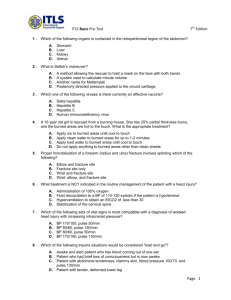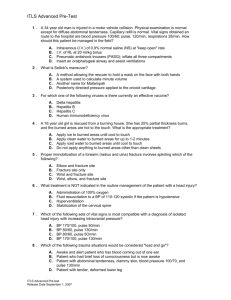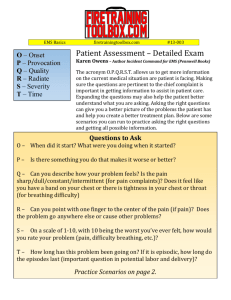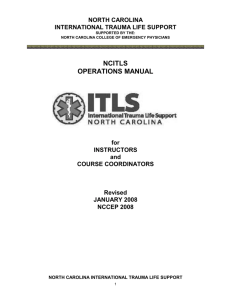ITLS Advanced Pre-Test 7th Ed: Trauma Knowledge Assessment
advertisement
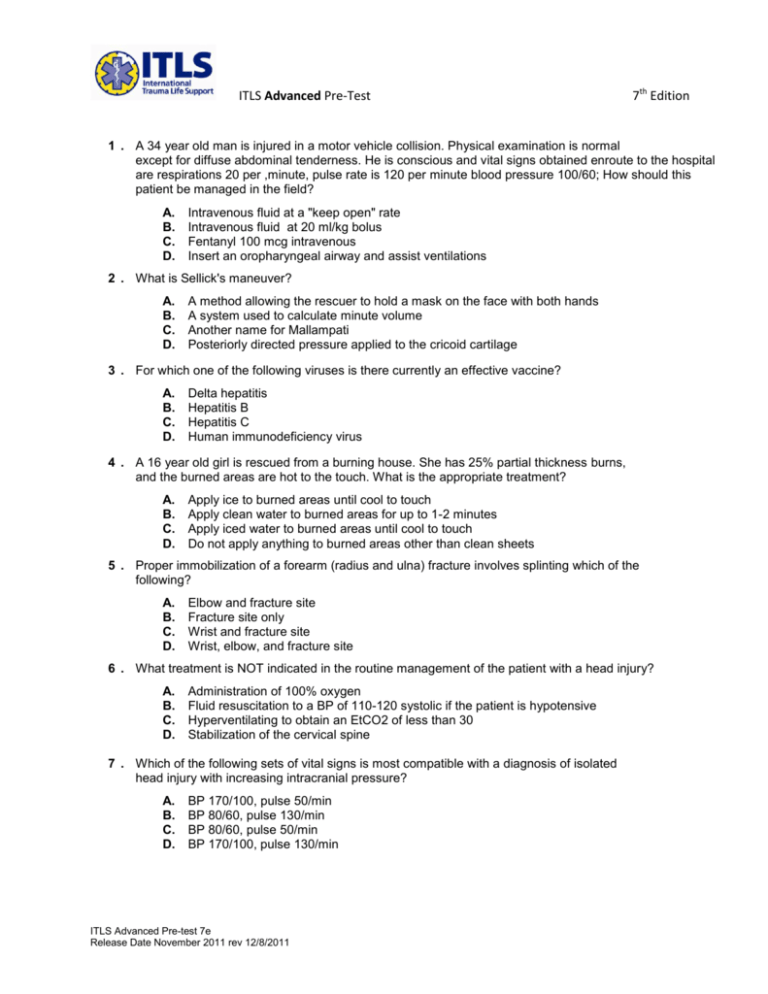
ITLS Advanced Pre-Test 7th Edition 1 . A 34 year old man is injured in a motor vehicle collision. Physical examination is normal except for diffuse abdominal tenderness. He is conscious and vital signs obtained enroute to the hospital are respirations 20 per ,minute, pulse rate is 120 per minute blood pressure 100/60; How should this patient be managed in the field? A. B. C. D. Intravenous fluid at a "keep open" rate Intravenous fluid at 20 ml/kg bolus Fentanyl 100 mcg intravenous Insert an oropharyngeal airway and assist ventilations 2 . What is Sellick's maneuver? A. B. C. D. A method allowing the rescuer to hold a mask on the face with both hands A system used to calculate minute volume Another name for Mallampati Posteriorly directed pressure applied to the cricoid cartilage 3 . For which one of the following viruses is there currently an effective vaccine? A. B. C. D. Delta hepatitis Hepatitis B Hepatitis C Human immunodeficiency virus 4 . A 16 year old girl is rescued from a burning house. She has 25% partial thickness burns, and the burned areas are hot to the touch. What is the appropriate treatment? A. B. C. D. Apply ice to burned areas until cool to touch Apply clean water to burned areas for up to 1-2 minutes Apply iced water to burned areas until cool to touch Do not apply anything to burned areas other than clean sheets 5 . Proper immobilization of a forearm (radius and ulna) fracture involves splinting which of the following? A. B. C. D. Elbow and fracture site Fracture site only Wrist and fracture site Wrist, elbow, and fracture site 6 . What treatment is NOT indicated in the routine management of the patient with a head injury? A. B. C. D. Administration of 100% oxygen Fluid resuscitation to a BP of 110-120 systolic if the patient is hypotensive Hyperventilating to obtain an EtCO2 of less than 30 Stabilization of the cervical spine 7 . Which of the following sets of vital signs is most compatible with a diagnosis of isolated head injury with increasing intracranial pressure? A. B. C. D. BP 170/100, pulse 50/min BP 80/60, pulse 130/min BP 80/60, pulse 50/min BP 170/100, pulse 130/min ITLS Advanced Pre-test 7e Release Date November 2011 rev 12/8/2011 ITLS Advanced Pre-Test 8 7th Edition . Which of the following trauma situations would be considered "load and go"? A. B. C. D. Awake and alert patient who has blood coming out of one ear Patient who had brief loss of consciousness but is now awake Patient with abdominal tenderness, clammy skin, blood pressure 100/70, and pulse 130/min Patient with tender, deformed lower leg 9 . Which one of the following should be performed, at the scene of a "load and go", prior to moving the trauma patient to the ambulance? A. B. C. D. Apply traction splint for femur fracture Decompress tension pneumothorax Initiate intravenous line Obtain vital signs 10 . Which one of the following is a reason to interrupt the initial assessment? A. B. C. D. Cardiac arrest Multiple open (compound) fractures Severe head injury with brain tissue visible Severe shock 11 . A 24 year old woman is found lying on the sidewalk after jumping from a fourth story window. She is hypotensive, diaphoretic, tachycardic, and unconscious. Injuries include open skull fracture, pelvis fractures, and flail chest. What should be your goal for your time? A. B. C. D. 5 minutes or less 5 to 10 minutes 10 to 15 minutes As long as necessary to assess and stabilize the patient 12 . Which of the following injuries would change an otherwise stable trauma patient's category from "stable" to "load and go"? A. B. C. D. Bilateral clavicle fractures Bilateral femur fractures Bilateral humerus fractures Bilateral tibia fractures 13 . What is most commonly injured, during a fall from a height, of an infant? A. B. C. D. Head Chest Abdomen Extremities 14 . What site is the first choice for intraosseous infusion? A. B. C. D. Proximal tibia Distal humerus Proximal femur Distal fibula ITLS Advanced Pre-test 7e Release Date November 2011 rev 12/8/2011 ITLS Advanced Pre-Test 7th Edition 15 . Which of the following will generally suffer the LEAST structural damage from a gunshot wound from a rifle? A. B. C. D. Spleen Kidney Liver Lung 16 . A 34 year old man has a gunshot wound to the right groin area. Arterial bleeding, which cannot be controlled with direct pressure, is coming from the wound. The patient appears confused, diaphoretic, and has weak peripheral pulses. What is the appropriate fluid resuscitation for this patient? A. B. C. D. Intravenous fluid at a "keep open" rate Apply a hemostatic agent and gain intravenous access given enough fluid to maintain peripheral pulses Intravenous fluid at a wide open rate; give at least two liters, then reassess patient No intravenous access should be established in this situation 17 . Which one of the following is typically associated with, post-traumatic hemorrhage, EARLY shock? A. B. C. D. Ventricular dysrhythmias Hypotension Loss of 30% to 45% of blood volume Narrowed pulse pressure 18 . Among the following, what is the most common cause of preventable trauma death in the injured adult patient? A. B. C. D. Airway obstruction Cardiac tamponade Hemorrhagic shock Spinal injury 19 . In which of the following situations should an emergency rescue be used? A. B. C. D. Leaking antifreeze from radiator Paralyzed patient Presence of toxic fumes Pregnant patient 20 . Which of the following is most typical of early, neurogenic shock? A. B. C. D. Increased pulse, clammy skin Increased pulse, warm and dry skin Decreased pulse, clammy skin Decreased pulse, warm and dry skin 21 . A 23 year old man is injured in a motorcycle collision. The patient appears disoriented and grossly intoxicated. There is a large laceration on his scalp, which is actively bleeding. The patient refuses treatment and threatens to call his lawyer if anyone touches him. What should you do? A. B. C. D. Allow the patient to phone his lawyer Have the patient sign a release form, then let him go Have the patient placed under protective custody then treat and transport the patient using restraints if necessary Wait until the patient passes out from his head injury or bleeding then transport ITLS Advanced Pre-test 7e Release Date November 2011 rev 12/8/2011 ITLS Advanced Pre-Test 7th Edition 22 . Which of the following is an acceptable location to insert a needle when decompressing a tension pneumothorax? A. B. C. D. Directly under the bottom of the second rib, midclavicular line Directly under the bottom of the third rib, midclavicular line Directly over the top of the fourth rib, midaxillary line Directly over the top of the third rib, midclavicular line 23 . A 54 year old man is involved in a motor vehicle collision. The steering wheel is bent. During your initial assessment you note his skin is pale and his radial pulses are present. Breath sounds are clear, heart tones are not muffled. Which one of the following is most consistent with these findings? A. B. C. D. Cardiac contusion Traumatic aortic rupture Flail chest Tension pneumothorax 24 . What is the most common cause of cardiopulmonary arrest in the trauma patient? A. B. C. D. Brain injury Hypoxemia Myocardial contusion Ventricular arrhythmia 25 . A 49 year old man is involved in a motor vehicle collision. First responders are doing CPR. Findings include a distended abdomen and obviously deformed pelvis and a quick look at the monitor shows asystole. Which of the following is the most appropriate act? A. B. C. D. Establish intravenous access and administer a 20mL/kg bolus Establish intravenous access and administer a 1 liter bolus Establish intravenous access and administer a 2-4 liter bolus Resuscitative efforts should not be started and the patient pronounced dead 26 . Which of the following statements concerning treatment of shock in the pregnant, burn patient is TRUE? A. B. C. D. Oxygen should be used sparingly so as to avoid oxygen toxicity to the fetus Pressor agents such as dopamine should be used to improve circulation to the fetus Volume replacement should be given earlier and in larger amounts to the pregnant, burn patient Volume replacement should be given more slowly so as to avoid fluid overloading the fetus 27 . Which area of the spine is most susceptible to injury in a rear-impact motor vehicle crash? A. B. C. D. Cervical Thoracic Lumbar Sacral-coccygeal ITLS Advanced Pre-test 7e Release Date November 2011 rev 12/8/2011 ITLS Advanced Pre-Test 7th Edition 28 . An unrestrained 18 year old male on the way to a post-graduation party leaves the road, bounces through a ditch and hits a tree. You find him behind the bent steering wheel, unconscious, cool, pale and clammy, blue around the lips with labored respirations of 30 and shallow, thready radial pulses of about 120, distended neck veins, tracheal deviation to the right, an asymmetrical chest with absent breath sounds on the left. You assume he has a A. B. C. D. Cardiac tamponade Tension pneumothorax Massive hemothorax Simple pneumothorax 29 . Which one of the following may predict which patients might have difficult laryngoscopy and intubation? A. B. C. D. Patients with dentures Patients with history of asthma Patients with an overbite Patients with beards 30 . An unrestrained 18 year old male on the way to a post-graduation party leaves the road, bounces through a ditch and hits a tree. You find him behind the bent steering wheel, unconscious, cool, pale and clammy, with labored respirations of 30 and shallow, thready radial pulses of about 120, flat neck veins, trachea midline, an asymmetrical chest with absent breath sounds on the left. You assume he has a A. B. C. D. Cardiac tamponade Tension pneumothorax Massive hemothorax Simple pneumothorax 31 . A 23 year old female has won the “Let’s-see-who-can-lean-the-farthest-backward-overthe-second-story-balcony-railing” contest. You arrive to find her boyfriend standing over her, holding two beers, as she lies on the grass under the balcony. She opens her eyes to voice, her skin is normal in color, respirations about 16 and unlabored, pulse 54 and a little weak at the wrist, with no external bleeding. She has flat neck veins, a normal chest and abdomen and a stable pelvis. First responders who arrived just before you tell you that her pulse ox reading is 94 and her BP is 74/30. If this is true, A. B. C. D. Hypovolemic shock Relative hypovolemic (high-space) shock Mechanical (obstructive) shock Cardiogenic shock 32 . A 23 year old female has won the “Let’s-see-who-can-lean-the-farthest-backward-overthe-second-story-balcony-railing contest. You arrive to find her boyfriend standing over her, holding two beers, as she lies on the grass under the balcony. She opens her eyes to voice, her skin is cool, clammy and ashen, respirations are rapid and shallow, radial pulses are too rapid to count and thready. There is no external bleeding. She has flat neck veins, a normal chest and abdomen and pelvis. Her boyfriend tells you that she has some kind of heart problem but he doesn’t know what. Placed on the monitor, she shows a wide-complex tachycardia of about 280. What kind of shock is she suffering? A. B. C. D. Hypovolemic shock Relative hypovolemic (high-space) shock Mechanical (obstructive) shock Cardiogenic shock ITLS Advanced Pre-test 7e Release Date November 2011 rev 12/8/2011 ITLS Advanced Pre-Test 7th Edition 33 . Which of the following would be the most compelling reason to intubate a patient immediately? A. B. C. D. Snoring respirations Gurgling respirations Inability to ventilate (achieve chest rise) Traumatic arrest 34 . Which of the following may affect the reliability of a pulse oxymetry reading? A. B. C. D. Cyanide poisoning High ambient light Carbon monoxide poisoning All of the above 35 . During the Primary Survey you recognize your patient is in need of immediate ventilator support, you delegate this intervention to a team member and you continue the Primary Survey. This delegation of interventions is called: A. B. C. D. the “Just Do It” process the “Treat It as You Find It” process the “Get It Done” process the “Fix It” process 36 . Which of the following conditions is your FIRST priority in management of a trauma patient? A. B. C. D. Open the airway and assess for breathing Provide ventilator support for your patient Control major external bleeding Begin chest compressions if pulses are absent 37 . In the absence of herniation syndrome, adult head injured patients should be: A. B. C. D. ventilated at a rate of 8-10 per minute ventilated at a rate of 12-14 per minute ventilated at a rate of 16-18 per minute ventilated at a rate of 20 per minute 38 . Supine hypotension syndrome in the pregnant patient is caused by:: A. B. C. D. uterine obstruction of venous blood flow atelectasis (collapse of small airways) of the lungs uterine pressure on the vagal nerve gastric reflux 39 . Which of the following has a greater chance of surviving traumatic cardiopulmonary arrest? A. B. C. D. Patients who suffer blunt force trauma to the torso Patients with non-dilated pupils Patients with dilated unresponsive pupils Patients with penetrating chest trauma who are hypothermic ITLS Advanced Pre-test 7e Release Date November 2011 rev 12/8/2011 ITLS Advanced Pre-Test 7th Edition 40 . Tourniquet application should be limited to less than: A. B. C. D. 1 hour 2 hours 3 hours 4 hours 41 . Hemostatic agents applied directly to the source of bleeding must be used in conjunction with: A. B. C. D. direct pressure to the wound tourniquets proximal to the wound pressure points to arteries proximal to the wound elevation of the wound above the level of the heart 42 . Which assessment tool(s) may assist in predicting patient deterioration for someone who otherwise appears stable? A. B. C. D. Serum lactate levels Blood sugar levels Abdominal ultrasound A&C 43 . Which of the following concerning blast injury is TRUE? A. B. C. D. Primary injury is cased by heat Secondary injury is caused by materials propelled Tertiary injury is caused by toxic fumes Quaternary injury is caused by the displacement of the body 44 . What are the most important factors in determining injuries sustained in a fall? A. B. C. D. Distance, impact area on the body, surface struck Distance, clothing worn, surface struck Distance, movement during the fall, underlying medical conditions Distance, underlying medical conditions, surface struck 45 . You have a patient with an isolated stab wound to the lateral chest. According to recent studies, which of the following procedures should be avoided? A. B. C. D. Assisting ventilations Supplemental oxygen Occlusive dressing Spinal motion restriction 46 . The “Golden Period” begins: A. B. C. D. at the time of injury at the time your unit is dispatched when your unit arrives on scene when your unit lease the scene for the hospital ITLS Advanced Pre-test 7e Release Date November 2011 rev 12/8/2011 ITLS Advanced Pre-Test 7th Edition 47 . Pulsus paradoxus is best described by which of the following? A. B. C. D. The radial pulse disappears upon inspiration The radial pulse is absent The radial pulse is stronger than the carotid pulse There are unequal radial pulses 48 . Which of the following is the correct orientation for inserting an intraosseous needle to the proximal tibia? A. Medial to the midline, avoiding the growth plate B. Medial to the midline, pointing towards the growth plate C. Lateral to the midline, avoiding the growth plate D. Lateral to the midline, pointing towards the growth plate 49 . A 35-year-old male is found at the scene of a motor vehicle collision. He is alert and oriented and complaining of knee pain. Your assessment reveals a respiratory rate of 16 per minute non-labored, pulse rate of 88 per minute strong, blood pressure 124/64, unequal pupils and swelling to the isolated knee injury. What is the most likely cause of the unequal pupils? A. B. C. D. Pre-existing condition (anisocoria) Increased intracranial pressure Alcohol intoxication Hypotension 50 . In the elderly which of the following findings is most likely caused by an acute injury? A. B. C. D. Edema of the lower extremities Hypotension Loss of lung tissue elasticity Decreased peripheral vision ITLS Advanced Pre-test 7e Release Date November 2011 rev 12/8/2011
